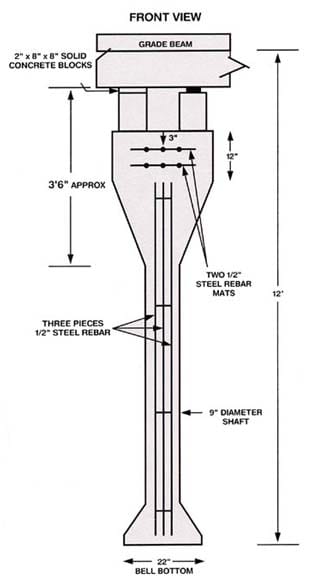Knowing the weight of your home will give you, the homeowner, a better appreciation of the weight being borne by the soil directed beneath the foundation. It should also give you a better appreciation of the tremendous forces of nature – that being soil movement, which is the primary cause of damage to concrete slab foundations in Texas.
Remember, the clay soils of Texas will shrink and swell in volume with changes in moisture content. During period of hot, dry weather the clay soils will lose water and shrink in volume. During periods of wet, rainy weather the clay soils will absorb water and swell in volume. This seasonal soil movement places huge stresses on rigid concrete foundations. And keep in mind that the foundation is supporting its own weight plus the weight of the house plus the weight of the contents inside the house.
The House + Foundation
For our analysis we are going to assume we are working with a 3 bedroom, 2 bath house with 2000 square feet. After checking with various sources we collected some guidelines that we can use to calculate the weight of an average house. However, there can be significant variations of weight based on the method of house construction and the materials used. For example, homes with tile or concrete tile roofs will weigh significantly more than similar homes with a composition shingle roof.
For our purposes, we are going to use the following figures from our construction and structural engineering friends. All houses below have a total of 2000 sqft. The “footprint” of the one story house is 2000 sqft. The “footprint” of the two story house is 1000 sqft. The “footprint” of the three story house is 667 sqft. All weights include the house + concrete slab foundation.
one story home – 200 pounds per square foot of the house “footprint” of 2000 sqft
two story home – 275 pounds per square foot of the house “footprint” of 1000 sqft
three story home – 350 pounds per square foot of the house “footprint” of 667 sqft
The Contents
There is also a significant amount of weight in the home from personal possessions, furniture, and appliances. Again the weight can vary from household to household. And some items, like a fully loaded fireproof filing cabinet can weigh 1400 pounds. However, we are going to use a round number of 10,000 pounds for the contents of our hypothetical house. Keep in mind that if the homeowner owns a lot of books or a home gym this number could be much greater.
The Total Weight
OK, we are ready to add it all up for our one story 2000 square foot house – the house + foundation + contents.
400,000 pounds – (200 pounds/sq ft x 2000 sq ft) – weight of house + concrete slab foundation
10,000 pounds – weight of household contents
410,000 pounds – Total

Factor of Safety
This total, 410,000 pounds, is more than 200 tons for our hypothetical house. So why have we gone through this exercise to know the weight of your home? Because we want you, the homeowner, to know that any foundation repair method will have to support tons of weight. “Factor of Safety” is an engineering term that indicates how much weight a support structure can bear. The cheaper and more common stacked concrete cylinder (pushed piles) methods have a factor of safety = 1 or incipient failure. “Incipient failure is a condition where any increase in load or condition will cause failure.” (from the page Comparison of Factor of Safety Between Bell-Bottom Piers and Pressed Piles.) Or stated another way, a foundation repair method with a factor of safety =1 is at its maximum weight bearing capacity and will begin to fail if any additional weight is added. We see this every week when people install pushed piles under their garage. As soon as the homeowner parks his car in the garage he has exceeded the weight bearing capacity of the pushed piles. Failure has begun.
On the other hand, Bell Bottom Piers have a factor of safety = 5 to 10. They can bear significantly more weight, now and in the future.
Read some of the engineering reports and studies on our website to learn more about the pros and cons of various foundation repair methods.
